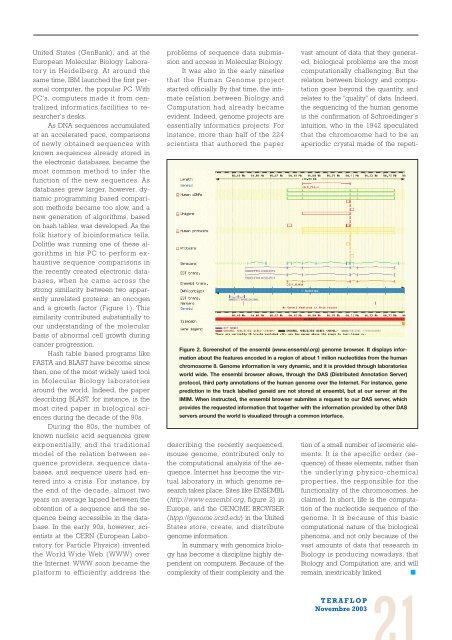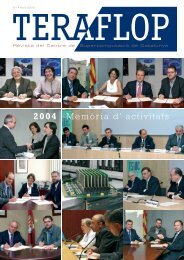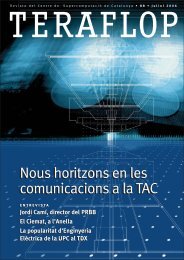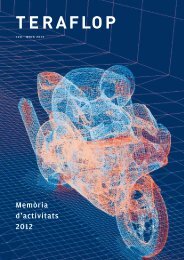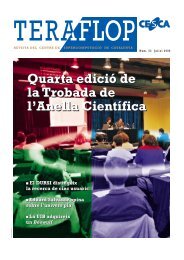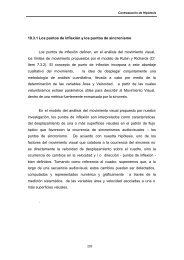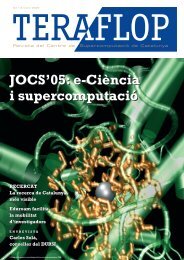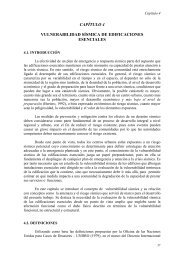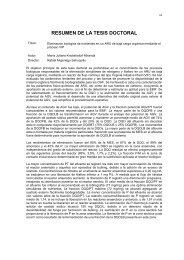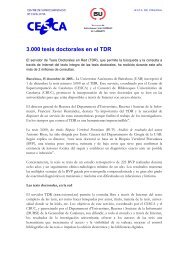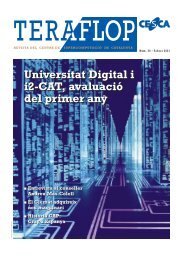Teraflop 73 - Novembre - cesca
Teraflop 73 - Novembre - cesca
Teraflop 73 - Novembre - cesca
You also want an ePaper? Increase the reach of your titles
YUMPU automatically turns print PDFs into web optimized ePapers that Google loves.
United States (GenBank), and at the<br />
European Molecular Biology Laboratory<br />
in Heidelberg. At around the<br />
same time, IBM launched the first personal<br />
computer, the popular PC. With<br />
PC's, computers made it from centralized<br />
informatics facilities to researcher's<br />
desks.<br />
As DNA sequences accumulated<br />
at an accelerated pace, comparisons<br />
of newly obtained sequences with<br />
known sequences already stored in<br />
the electronic databases, became the<br />
most common method to infer the<br />
function of the new sequences. As<br />
databases grew larger, however, dynamic<br />
programming based comparison<br />
methods became too slow, and a<br />
new generation of algorithms, based<br />
on hash tables, was developed. As the<br />
folk history of bioinformatics tells,<br />
Dolittle was running one of these algorithms<br />
in his PC to perform exhaustive<br />
sequence comparisons in<br />
the recently created electronic databases,<br />
when he came across the<br />
strong similarity between two apparently<br />
unrelated proteins: an oncogen<br />
and a growth factor (Figure 1). This<br />
similarity contributed substantially to<br />
our understanding of the molecular<br />
basis of abnormal cell growth during<br />
cancer progression.<br />
Hash table based programs like<br />
FASTA and BLAST have become since<br />
then, one of the most widely used tool<br />
in Molecular Biology laboratories<br />
around the world. Indeed, the paper<br />
describing BLAST, for instance, is the<br />
most cited paper in biological sciences<br />
during the decade of the 90s.<br />
During the 80s, the number of<br />
known nucleic acid sequences grew<br />
exponentially, and the traditional<br />
model of the relation between sequence<br />
providers, sequence databases,<br />
and sequence users had entered<br />
into a crisis. For instance, by<br />
the end of the decade, almost two<br />
years on average lapsed between the<br />
obtention of a sequence and the sequence<br />
being accessible in the database.<br />
In the early 90s, however, scientists<br />
at the CERN (European Laboratory<br />
for Particle Physics) invented<br />
the World Wide Web (WWW) over<br />
the Internet. WWW soon became the<br />
platform to efficiently address the<br />
problems of sequence data submission<br />
and access in Molecular Biology.<br />
It was also in the early nineties<br />
that the Human Genome project<br />
started officially. By that time, the intimate<br />
relation between Biology and<br />
Computation had already became<br />
evident. Indeed, genome projects are<br />
essentially informatics projects. For<br />
instance, more than half of the 224<br />
scientists that authored the paper<br />
describing the recently sequenced,<br />
mouse genome, contributed only to<br />
the computational analysis of the sequence.<br />
Internet has become the virtual<br />
laboratory in which genome research<br />
takes place. Sites like ENSEMBL<br />
(http://www.ensembl.org, figure 2) in<br />
Europe, and the GENOME BROWSER<br />
(htpp://genome.ucsd.edu) in the United<br />
States store, create, and distribute<br />
genome information.<br />
In summary, with genomics biology<br />
has become a discipline highly dependent<br />
on computers. Because of the<br />
complexity of their complexity and the<br />
vast amount of data that they generated,<br />
biological problems are the most<br />
computationally challenging. But the<br />
relation between biology and computation<br />
goes beyond the quantity, and<br />
relates to the "quality" of data. Indeed,<br />
the sequencing of the human genome<br />
is the confirmation of Schroedinger's<br />
intuition, who in the 1942 speculated<br />
that the chromosome had to be an<br />
aperiodic crystal made of the repeti-<br />
Figure 2. Screenshot of the ensembl (www.ensembl.org) genome browser. It displays information<br />
about the features encoded in a region of about 1 milion nucleotides from the human<br />
chromosome 8. Genome information is very dynamic, and it is provided through laboratories<br />
world wide. The ensembl browser allows, through the DAS (Distributed Annotation Server)<br />
protocol, third party annotations of the human genome over the Internet. For instance, gene<br />
prediction in the track labelled geneid are not stored at ensembl, but at our server at the<br />
IMIM. When instructed, the ensembl browser submites a request to our DAS server, which<br />
provides the requested information that together with the information provided by other DAS<br />
servers around the world is visualized through a common interface.<br />
tion of a small number of isomeric elements.<br />
It is the specific order (sequence)<br />
of these elements, rather than<br />
the underlying physico-chemical<br />
properties, the responsible for the<br />
functionality of the chromosomes, he<br />
claimed. In short, life is the computation<br />
of the nucleotide sequence of the<br />
genome. It is because of this basic<br />
computational nature of the biological<br />
phenoma, and not only because of the<br />
vast amounts of data that research in<br />
Biology is producing nowadays, that<br />
Biology and Computation are, and will<br />
remain, inextricably linked. ■<br />
TERAFLOP<br />
<strong>Novembre</strong> 2003


